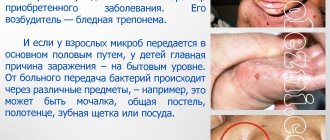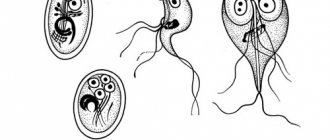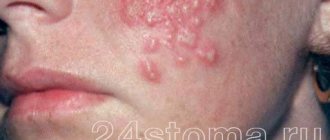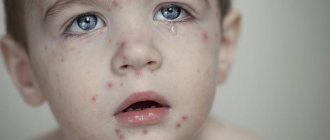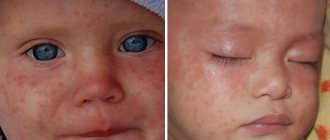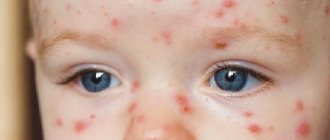Chicken pox
Symptoms.
The child’s temperature rises to 37.5-38.0 C, and almost immediately a characteristic blistering rash appears. Moreover, the first spots are usually visible at the junction of the scalp and forehead; in subsequent days, the rash spreads to the entire body. Only a doctor can reliably determine the nature of the rash and make a diagnosis! Therefore, the best thing you can do for your child is to call a pediatrician. This infection occurs easily in young children (up to 5-6 years old). At older ages, the disease is more severe, often with symptoms of general intoxication. The disease is caused by the herpes virus type 3, it is very contagious, so if someone in a kindergarten group gets sick, then everyone who was in contact will get sick.
Symptoms in adults
The course of rubella in adults is more severe than in children. Moreover, the former are diagnosed with the same forms of pathology as the latter.
Symptoms are similar to those of rubella in children:
- the appearance of a rash on the skin;
- symptoms of intoxication.
The difference in the course of the disease in adults and children is that in the former the pathology manifests itself more intensely. They also often experience various complications:
- decreased platelet levels in the blood;
- joint damage;
- the appearance of encephalitis.
Rubella: photos in adults
Researchers suggest that this difference in the intensity of the pathology is due to adults’ adherence to bad habits and the presence of diseases that affect the immune system.
Rubella.
Symptoms.
Rubella begins with an enlargement of the occipital lymph nodes, an increase in temperature to 38-39.0 C. A little later, a runny nose and sometimes a cough appear. A rash appears 2-3 days after the onset of the disease. Rubella is characterized by a pinpoint, pink rash that begins with a rash on the face, neck, and then spreads throughout the body. The rash can remain on the body from several hours to 2-3 days, and then disappears without a trace. Children tolerate the disease without consequences.
The rubella virus is dangerous primarily for pregnant women, as it leads to irreversible developmental disorders of the fetus. In addition, rubella is very easy to get sick - just spend some time indoors with a sick person. Therefore, for the safety of expectant mothers, vaccination is included in the national vaccination calendar.
Complications practically do not occur. After the disease, a strong immunity is developed, and recurrent disease is very rare.
Contagiousness
The rubella virus is spread from person to person through tiny droplets of fluid from the nose and throat when sneezing and coughing. People with rubella are most contagious 1 week or more before the rash appears and up to 1 week after it appears. Someone who is infected but has no symptoms can also spread the virus.
Infants with congenital rubella syndrome can shed the virus in their urine and nasal mucus for a year or more, which means they can infect unvaccinated people.
Parotitis
People also call it “pig”. This childhood viral infection is characterized by acute inflammation in the salivary glands. Infection occurs by airborne droplets. “Mumps” begins with an increase in body temperature to 39C, severe pain in the ear area or under it, aggravated by swallowing or chewing. At the same time, salivation increases. Swelling in the upper neck and cheek area increases quite quickly; touching these places causes severe pain in the child. This disease itself is not dangerous; unpleasant symptoms disappear within 3-4 days. However, quite often mumps ends in inflammation in glandular organs such as the pancreas and gonads. Pancreatitis in some cases leads to diabetes mellitus. Inflammation of the gonads (orchitis) is more common in boys. This significantly complicates the course of the disease, and in some cases can result in infertility. In particularly severe cases, mumps can be complicated by viral meningitis, which is severe but not fatal. Given such a number of possible complications, vaccination against mumps has been included in the national calendar.
First signs
The rash in pictures of rubella is often mistaken for the primary signs of the disease, but several pre-existing conditions allow one to suspect something is wrong. So, a few days before the obvious manifestation of symptoms, the patient begins to experience weakness, malaise, and becomes slower. Body temperature rises to around 38.
Measles
Symptoms.
The disease begins with severe headache, weakness, and fever up to 40.0 C. Later, a runny nose, cough, and complete lack of appetite begin. Measles is characterized by the appearance of conjunctivitis - inflammation of the mucous membrane of the eye, which is manifested by photophobia, lacrimation, and severe redness of the eyes. These symptoms last 2-4 days. On day 4, a rash appears that looks like small red spots of varying diameters. The rash appears on the face and head (especially localized behind the ears) and spreads throughout the body within 3-4 days. It is very characteristic of measles that the rash leaves behind pigmentation (dark spots that last for several days), which disappears in the same sequence as the rash appeared.
The disease, despite its rather clear clinical picture, is well tolerated by children, but is fraught with serious complications. These include pneumonia, otitis media, encephalitis (inflammation of the brain). It must be remembered that after suffering from measles for a long time (up to 2 months), there is suppression of the immune system, so the child may get sick with some kind of cold or viral disease. It is necessary to protect him from excessive stress and contact with sick children. Immunity after measles is lifelong.
The disease is characterized by very high susceptibility. If a person has not had measles or has not been vaccinated against this infection, then after contact with a sick person, infection occurs in almost 100% of cases. The measles virus is very volatile - it can even spread through ventilation pipes and elevator shafts, while children living on different floors of the house simultaneously become ill.
What kind of disease is this?
Rubella develops against the background of infection of the body with togavirus.
There are three ways of transmission of infection:
- direct contact with the carrier of the pathogen;
- being in a room where the carrier is present;
- transmission of the virus from an infected pregnant woman to her child (transplacental route).
In comparison with other infections (measles, whooping cough, etc.), the virus in question is characterized by weak resistance to the effects of the surrounding atmosphere: outside the human body, it remains viable for one hour. In particular, infectious pathogenic microflora dies in acidic and alkaline environments, as well as at temperatures above 56 degrees.
Understanding how the infection is transmitted explains why rubella occurs more often in children . In addition, the high prevalence of pathology in patients aged 2-9 years is due to the absence of an antigen to the virus in their body.
The likelihood of contracting an infection is high within two weeks, calculated from the beginning of the incubation period.
The virus enters the human body mainly through the mucous membranes of the upper respiratory tract. In rare cases, infection occurs through microscopic wounds in the skin. Infectious microflora penetrates through the bloodstream into the lymph nodes, where it settles and begins to actively develop. Subsequently, when the virus begins to penetrate the skin, an immune response occurs, manifested in the form of characteristic signs of the disease - rashes.
Scarlet fever
Symptoms.
Scarlet fever begins acutely with a rise in temperature to 39-40.0 C and vomiting. Severe intoxication and headache are immediately noted. The most characteristic symptom of scarlet fever is sore throat. Patients report acute pain when swallowing. There may be a whitish coating on the tongue and tonsils. The tongue subsequently acquires a characteristic appearance - “raspberry tongue” (bright pink, coarse-grained). On day 2 a rash appears. Its distinctive feature is that the bright red, pinpoint rash is located on a red background, which creates the impression of a general confluent redness. When you press on the skin, a white spot remains. The rash can be located all over the body, but the area between the upper lip and nose and chin always remains clean. The rash lasts from 2 to 5 days. Symptoms of sore throat remain somewhat longer (from 7 to 9 days).
Scarlet fever is the only “childhood infection” caused not by a virus, but by bacteria (group A streptococcus).
This acute disease is transmitted by airborne droplets, and infection through household items (toys, dishes) is also possible. Children of early and preschool age are sick. Patients are most at risk for infection in the first 2-3 days of the disease. Only children suffer from scarlet fever, since adults are already resistant to streptococcus. Those who have recovered also acquire lasting immunity. Immunity after childhood infections is developed almost throughout life, and having been ill once, a person is unlikely to get sick again. Vaccines protect against measles, rubella, mumps, and chickenpox, although even after vaccination, about 3% of children may get sick (this is due to the individual characteristics of the immune system). By following the National Vaccination Calendar, you can protect your baby from most “childhood infections”!
Childhood infections: whooping cough, scarlet fever, measles, chickenpox, rubella and mumps
There are a number of infectious diseases that are commonly called childhood diseases, since they occur mainly in childhood. As a rule, a child gets sick from childhood infections only once, then he develops strong immunity for life. Childhood infections include measles, rubella, scarlet fever, chickenpox (chickenpox), mumps (mumps) and whooping cough.
Symptoms and treatment of chickenpox in children (chickenpox)
If, after a short increase in body temperature, runny nose and redness of the eyes/throat, rashes appear on the child’s body, then any mother will understand that it is chickenpox. All parents should know the symptoms and treatment of chickenpox in children, because it is important not only to diagnose the infection in time, but also to carry out proper treatment.
The first sign of chickenpox is a characteristic rash - small, reddish-pink nodules with jagged edges that most often appear on the face and upper extremities. After a few hours, a small bubble forms on the surface of the nodule, which is filled with a translucent yellowish liquid. After 8-12 hours, the blisters open on their own, the rash becomes covered with a dense crust, which gradually disappears.
The incubation period for chickenpox is 3-5 days; at this stage it is not possible to detect the disease. When the first symptoms of chickenpox appear, parents should consult a doctor (call him to your home), but no specific treatment will be prescribed. For chickenpox, it is recommended to carry out symptomatic therapy - for example, a child may need antipyretic drugs, drugs that relieve itching of the skin. It is extremely rare for doctors to prescribe Cycloferon, which can prevent the development of a purulent bacterial infection against the background of chickenpox, which significantly alleviates the course of the disease.
Chickenpox infection in a kindergarten means its closure for quarantine.
Symptoms and treatment of scarlet fever in children
Scarlet fever is an acute infectious disease that is characterized by intoxication, fever and profuse pinpoint rash. The source of infection is a sick child or a healthy carrier of streptococci - it is this pathogenic microorganism that provokes the development of scarlet fever.
The symptoms and treatment of scarlet fever in children are well known to doctors, so there will be no problems with diagnosis. This disease always begins acutely, with a sharp rise in temperature, up to 39 degrees. The child complains of headache and nausea, and there is pain when swallowing. Already at the end of the first day of the disease, a small and itchy rash appears, which quickly covers the entire body. The skin becomes excessively dry to the touch, reminiscent of sandpaper.
Treatment of scarlet fever is carried out at home; only in case of severe illness, the child can be admitted to hospital. To suppress streptococcus, antibacterial therapy is prescribed; the throat must be gargled with a solution of furatsilin or infusions of chamomile/calendula. As part of the treatment of scarlet fever, antihistamines and vitamins are prescribed without fail.
Symptoms and treatment of whooping cough in children
Most often, children under 5 years of age who have not been vaccinated become infected with whooping cough. It is generally accepted that whooping cough is most dangerous for children in the first year of life; at older ages, the disease is milder.
All parents need to know the symptoms and treatment of whooping cough in children, because this disease is infectious and a sick child can infect all surrounding children. As a rule, the disease begins with a slight increase in temperature, general weakness and a slight cough. Then, after a few days, the child begins to be bothered by a specific cough with tears and spasms, upon hearing which the pediatrician will immediately suspect whooping cough. It is noteworthy that before the appearance of this whooping cough, parents consider their child to be healthy, but slightly cold - he may even attend preschool, which leads to the spread of infection.
Treatment is prescribed by a doctor, having previously done a test for whooping cough - bacterial culture of biomaterial from the throat of a sick child. This, firstly, makes it possible to clarify the diagnosis, and secondly, it helps to identify the true causative agent of the infection and select competent/effective treatment.
As a rule, treatment is carried out with the help of antibacterial drugs; antihistamines and antitussives are also prescribed.
Mumps, measles and rubella
These diseases are also considered infectious and dangerous. For example, the symptoms of mumps in children will be as follows:
- temperature rise up to 40 degrees;
- pain in the ear area;
- increased salivation;
- pain when chewing and swallowing;
- swelling of the cheek on the side of the affected parotid gland.
It is extremely rare, but the virus can damage the meninges (meningitis), kidneys, and pancreas (pancreatitis progresses). In boys, mumps most often causes infertility, although there are exceptions.
Among childhood infections, there are two diseases that have a similar sign - the rash with measles and rubella looks like an accumulation of semolina grains. Redness of the skin at the site of the rash will be characteristic of both measles and rubella. It is considered an excellent sign if a girl had rubella in childhood - antibodies to rubella are produced in the body for life, and this infectious disease does not threaten during pregnancy. If a woman has suffered from rubella during pregnancy, this is fraught with miscarriage, fetal death, or the birth of a child with severe developmental disorders. A woman at the planning stage of pregnancy can be vaccinated against rubella, which will protect her and her unborn baby from problems in the future.
Prevention of childhood infections
Let’s say right away that prevention means vaccinating a child. It is worth knowing that there is no vaccine against chickenpox, but measles, rubella and scarlet fever can be prevented. This specific vaccination is well tolerated by children; extremely rarely, after the vaccine is administered, the baby’s body temperature may rise.
Many parents refuse vaccinations, but preventing rubella and scarlet fever in any other way is simply impossible, and the consequences of infectious diseases can be truly terrible, including complete disability.
Based on materials from the site dobrobut.com
Vaccine injection site
The complex vaccine is administered in two ways - subcutaneously or intramuscularly. Children under three years of age are most often vaccinated in the outer thigh, and subsequently in the deltoid brachialis muscle.
The choice of such places for vaccination is explained by the fact that here the skin is very thin, there is little subcutaneous fat and the muscles are very close. When the vaccine gets into the fatty layer, it is deposited, enters the blood slowly and subsequently does not have the desired effect.
The buttocks are also not suitable for vaccine administration due to the inaccessibility of the gluteal muscles for the vaccination needle, due to the developed subcutaneous fat in these areas.
What not to do after vaccination
After immunization, the following rules must be observed:
- The first half hour after vaccination must be under the supervision of a doctor.
- Taking water procedures after vaccination is not prohibited, but it is not advisable to wet or rub the injection site for a long time, in order to avoid a local reaction.
- Introduce new, especially exotic, foods into the diet, the body’s reaction to which has not yet been studied.
- For a couple of days after vaccination, you should not be in crowded places so as not to become infected with a common ARVI and not confuse it with a reaction to the vaccine.
On the eve of vaccination, you should consult with your doctor about what medications you should have at home as an emergency and for the first symptoms of a reaction to the vaccine.

